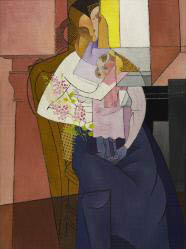
Italian, 1883 - 1966
1916
Oil on burlap
52 1/4 x 38 3/8 in. (132.7 x 97.5 cm)
Framed: 53 x 40 1/2 x 2 1/8 in. (134.6 x 102.9 x 5.4 cm)
Severini had his first major solo exhibition in America at Alfred Stieglitz’s gallery 291 in 1917, and his abstract portrait Femme et enfant was among the show’s featured artworks. Although closely associated with Italian Futurism, Severini lived in Paris during the height of this art movement and was equally inspired by Picasso’s and Braque’s Cubism, resulting in the development of his own distinct style: a fusion of Futurism and Cubism. His rendering of Femme et enfant is in line with the second Futurist Manifesto, which he signed in 1910: “A figure is never stable in front of us but is incessantly appearing and disappearing.” Mother and child seem to simultaneously dematerialize and re-emerge in the faceting of the composition. Severini’s gradation of iridescent, luminous colors creates a pulsating rhythm, which is further emphasized by the dynamic contrast of soft, curved lines and sharp, angular, and prismatic forms. Mother and child are highlighted by bright white, yellow, and pink fields guiding the viewer’s eyes to the center of the painting.